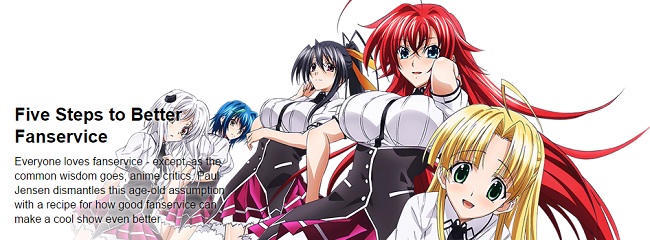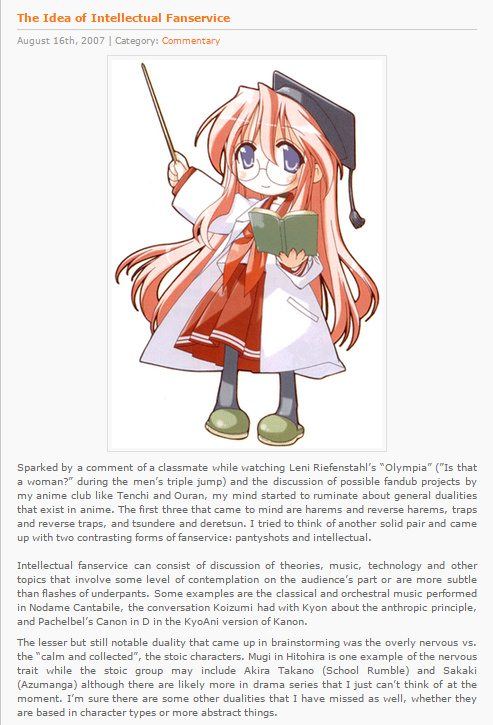
A feature article called “Five Steps to Better Fanservice” went up on ANN this week. Its author, Paul Jensen, made some good points about moderation and setting audience expectations early on in a series. However, the piece’s focus on the common interpretation of the term “fanservice” with regard to anime – body parts, hot spring/beach trips, etc. – left me a little disappointed after I finished reading it. I began to think about other types of fanservice and remembered an old post of mine that briefly touched on that notion.

It’s been about eight years since I wrote “The Idea of Intellectual Fanservice” on a previous iteration of this blog. Looking back at it now, I’m surprised at how short that post actually was. I was in Germany at the time as part of a one-month summer study-abroad program and my Internet access was limited to occasionally open computers at a university and a couple of net cafes in town so I couldn’t really sit down and type for extended periods of time. I can see how I might compose it differently in 2015 with less of a focus on dualities and more on intellectual fanservice as just one form of alternative fanservice.
A bunch of anime series have debuted since the summer of 2007 that feature bodily fanservice – some that came to my mind while writing this post were Cat Planet Cuties (Asobi ni Iku yo!), Kill La Kill, Highschool of the Dead, Strike Witches, To Love-Ru, High School DxD, and Infinite Stratos among many others.
There are also some series that managed to be bawdy without having much visual titillation like Seitokai Yakuindomo, Panty & Stocking with Garterbelt, and Azazel-san. I guess MM!, Hen Zemi‘s TV series, Shimoneta, and Seitokai no Ichizon could perhaps fall into that category but I haven’t watched any of those yet so I can’t really speak much about them from experience.
So what are some forms of alternative fanservice as opposed to carnal ones?
– There are shows abounding with Japanese cultural references such as Sayonara Zetsubou Sensei, Joshiraku and Hozuki no Reitetsu.
– There’s also ones that deal with high-minded concepts and theory like Kaiba, Madoka, Penguindrum, and Yuri Kuma Arashi.
– Musically-focused series like Nodame Cantabile and Sound! Euphonium feature characters performing pieces that some viewers might remembering playing on instruments in the past or seeing and hearing those performances may just bring back certain musician or listener experiences.
– Culinary-themed series such as Food Wars, Gourmet Girl Graffiti, and Toriko contain what you could call “food service” with characters shown cooking and eating appetizing dishes.
– Sega Hard Girls is an instance of retro game-related fanservice with its boatload of references to characters and titles from Sega’s long history.
– Emily wrote a post in April about The Disappearance of Nagato Yuki-chan and its visual callbacks to elements from the greater Haruhi franchise. That’s in-franchise fanservice in a way.
Before wrapping up, I wanted to bring up high-quality fluid animation that’s sometimes classified as sakuga. The portion of the overall anime audience that pays close attention to fantastic cuts and certain animators’ work is a interesting group to me since they spotlight stunning examples of artistry in motion and dig deeper than someone who would look at the same clips and be satisfied in saying “that looks cool!” before moving on.
However, I think I’d be reaching if I called sakuga a form of fanservice compared to the other forms I mentioned earlier. A particular animator will work on many different projects and the appreciation they’re given by that community seems to be more focused on the style and techniques they use. There are fans of individual animators, directors, writers, voice actors and production studios but I feel like those are somehow more specific than, say, shots of beautiful-looking food. I don’t know, I can’t nail down why I’m separating that from the rest…
Thanks for reading. This topic worked much better as a post than as a string of tweets the way my thought process works. Feel free to point out where I’m wrong about aspects of shows I mentioned and if there are better examples I should have used. I know there’s probably more cases of alternative fanservice in various manga series over the decades but I figured I would focus on anime first since I lack the breadth of knowledge to include many manga examples.

Fujoshi-related fanservice is a big one, in my opinion. There are many levels to it, from the very obvious — scenes of physical proximity, awkward poses, almost kisses — to the more subtle, which can really include any degree of relationship tension and drama. Strong rivalries and childhood friendships between male characters obviously aren’t always intended to be fanservicey to fujoshi, but for many anime adaptations of manga not intended for a female audience (many sports series come to mind, including Kuroko and Yowapeda), many scenes are definitely reframed in ways to attract fujoshi. And fujoshi-related fanservice has definitely been used in a humorous fashion in a lot of series (Naruto comes to mind), in ways not dissimilar to how self-aware a lot of traditional fanservice has become.
there also TechPorn which detail of various mechanical equipment become fanservice. Sega Hard Girls is one example, other could be Gun, Airship, Car, etc
SceneryPorn, where anime goes to detailed scenery like Aria/Aqua, KyoAni anime, or rarely desert / ruin / underwater scene.
I’m all for an expanded definition of fanservice, but I think we have to draw the line somewhere between the ones we can commonly agree and things that are just, for example, references. My issue with the ANN article (and to a lesser degree also yours) is this non-definition of what we are even talking about, especially in the context of otaku media.
One example that sort of talks about the “sakuga” category you referred to is the dance scenes in idol anime of recent years. Or in the more common form: monster/fight of the week formulas. In these kind of scenes, the production style or animation direction or even the choreography can all convey fanservice of various types. It could just be flashing some flesh, or some suggestive movements, or some kind of “database” element in reference to something to the conveyance of some fanservice goals. Or even other things I can’t remember off top of my head.
The real question I think isn’t so much what is a reference and what is a fanservice element based on reference, but defines what makes fanservice “service.” For example, it’s very clear that the last episode of Fate/stay night UBW is such a thing, but it’s not only because it’s full of references to the rest of Nasuverse. It’s not like how, say, Sore ga Seiyuu is full of references to the day and life of seiyuu work, but it delivers a specific, context-sensitive narrative that hardcore seiyuu otaku can appreciate in a specific sense (say, Aice5 getting back together). This is kind of different, say in Shirobako, when you have a narrative that everyone can get on board, but you drop Itano (and his circus) as a “fanservice” element. It’s also beyond just a superfluous reference since he is a famous example of the subject matter in discussion in that episode.
To rephrase the same question, it’s like saying what’s the point of fanservice if it’s in the service of the greater good? If it bring brevity, positively changes the mood and refreshens pacing, does it necessarily have anything to do with “fanservice” anymore? What’s the big deal about showing some flesh in the first place, anyway? Isn’t fanservice, by some definition, at the sacrifice of something else? Does fanservice even exist in ero anime?